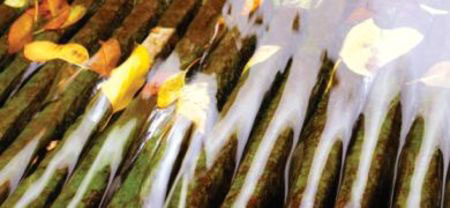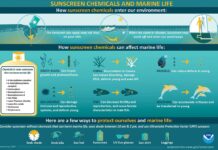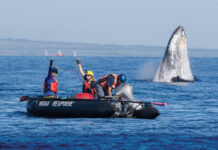Paul Wood
 They’ve been in the news and they will be in the news. Their fate, once resolved, will set precedents for reformed water-use policies statewide. So it’s likely that what goes down in Wailuku will influence the future of kalo (taro) farming, of Hawaiian culture, and of agriculture throughout Hawai‘i. Their freshwater capacity—not very much, just sixty million gallons a day collected from surface flow and from holes drilled into the mountain to pump up “groundwater”—sets a natural limit on the growth of Maui’s population. Seems to me that anybody who turns a tap or flushes a toilet on the island of Maui ought to take a look at Na Wai ‘Eha.
They’ve been in the news and they will be in the news. Their fate, once resolved, will set precedents for reformed water-use policies statewide. So it’s likely that what goes down in Wailuku will influence the future of kalo (taro) farming, of Hawaiian culture, and of agriculture throughout Hawai‘i. Their freshwater capacity—not very much, just sixty million gallons a day collected from surface flow and from holes drilled into the mountain to pump up “groundwater”—sets a natural limit on the growth of Maui’s population. Seems to me that anybody who turns a tap or flushes a toilet on the island of Maui ought to take a look at Na Wai ‘Eha.
They are “the Four Waters”—the four big streams that roll every day out of deeply sliced canyons on the windward side of Mauna Kahalawai. (People say “the West Maui Mountains,” but it’s actually one mountain, a single deeply eroded volcano.) Long ago, the streams dumped masses of good alluvial soil over a seven-mile swath at the base of the mountain, and the Hawaiians built auwai (stone ditches) to divert water into this area, the largest continuous field of wetland kalo cultivation in the Islands. These days, houses are covering the old farmlands, more every day, and the formerly mighty waters get sucked away to formerly arid places, giving life to Kihei lawns, isthmus sugarcane, and County Building restrooms.
Any concerned citizen can drive around and look at these streams and ditches. For example, next to the Wells Park tennis courts in the heart of downtown Wailuku, you can look into the rippling liquid of the Spreckels Ditch, built in 1882 and still drawing water from streams into reservoirs located just behind Maui’s prison. On Lower Waiehu Beach Road you can park and look into the trashed gulch that is Waiehu Stream. This article invites you to look at Na Wai ‘Eha, and look at the mountain, and look at the clouds, and look at the island from water’s viewpoint. It also invites you to look through the lenses of different contenders in lawsuits and public hearings we will all be hearing about for years to come.
Perhaps this piece will inspire a Sunday drive.
The Outsider’s Viewpoint
Begin at the spiritual heart of the island, ‘Iao Valley State Park, where the power and joy of free water reign supreme. Cool gusts rinse away the heat of town, mists cling to the steep mountain slopes, and brisk stream water muscles and chatters its way over domelike stones. Laughing tourists shoot pictures of local kids leaping into pools. There’s even a small lo‘i kalo (taro patch), one of the few that remain in Na Wai ‘Eha. You’re at the headwaters of Maui’s largest watercourse, the Wailuku Stream. We tend to call it the ‘Iao Stream for good reason—except in times of flood, the water never escapes naturally from the valley.
After the stream tumbles merrily out of ‘Iao State Park, it hits an “intake”—a grate laid cleverly all the way cross-stream. The stream falls into the grate and disappears. End of stream.
Now take those laughing, gladdened tourists down to the other end of Wailuku Stream, where it meets the sea, and watch their expressions change to horror and confusion. Not a drop of life remains. The riverbed is scraped flat and hardened with concrete. Towering cement walls mock the emptiness of the channel. The place begs for a graffiti artist to give it some life.
Our hypothetical tourists turn to you and ask, “What have you done with your greatest waterway? What kind of people are you?”
You shrug. “We needed the water.”
“For what?”
“Sugarcane at first. Now houses and golf courses. In fact, there wasn’t enough water, so we started digging into the mountain to pump groundwater out of the rock.”
“So you’re sucking the mountain dry.”
“No, no. The aquifer—that’s what they call that whole area, an aquifer—it gets recharged. It fills up again naturally.”
“What fills it up?”
“Water seeps into the ground from the running strea—“
You point, then look back. “Uh oh.”
The Scientist’s Viewpoint
“We’re borrowing from the future,” says Skippy Hau, biologist for over two decades with the state Division of Aquatic Resources. “It’s the impatience of modern society. We don’t want to wait the twenty or thirty years necessary for water to filter back into the aquifer.”
Our impatience contrasts sharply with the patience shown by numerous species of fish, shrimp, and snails that have been waiting more than a century for a good opportunity to follow nature’s urge and travel from the sea up the Wailuku Stream. (These creatures are diadromous—like salmon, they must migrate from saltwater to fresh.) For example, many types of ‘o‘opu want to climb the stream, not by flipping muscularly like salmon but by arduously climbing sheer stones with belly fins modified into suction cups. They want to scale the stream so they can bask and fatten in the kalo-planter’s auwai. The kalo planter wants this because one fat little ‘o‘opu goes well with poi. His meat comes up to him from the sea. He, in return, lets his only slightly used kalo water run right back into the stream. The natural mauka-to-makai (mountain-to-sea) circulation describes the main engine of pre-industrial living on Maui. In Na Wai ‘Eha that engine has been cut off. Today if a storm gluts the upper streams so that they briefly overflow their intakes, the ‘o‘opu will start their ascent. But you can only get so far in a day on belly fins, and the opportunity dries up quickly.
After one mountain storm caused the Wailuku Stream to flow again, Skippy looked into the channel behind Sack ’n Save and saw a thin red streak in the transparent trickle. It was a line of hihiwai, sea snails, laying down a mucous trail, determined to reach higher waters of the river, the state park four miles away. But since they can only travel about five feet a day, they were in deep trouble.
Skippy Hau says, “If a storm comes, people think, oh, everything’s okay [with the aquifer]. But we’re still pumping and developing. Who’s policing it? We need to be much more conscientious about where potable water is going.”
The Army Corps of Engineers
Raging streams are not safe, especially when a town (Wailuku, for example) keeps clustering along the banks. In 1950, Maui’s largest stream overwhelmed the intakes and tore up its banks, causing $20 thousand in damage. Certainly that was no Katrina, not even when you multiply the cost by sixty years’ inflation. But it does show that the wild waterway sometimes caused authorities to worry. For help in prevention of such flash-flood upheavals, the County turned to the masters of environmental control, the Army Corps of Engineers. The current concretization project, which can be glimpsed both above in Happy Valley and below on the bridge behind Sack ’n Save, took form in the early 1980s.
In 1999 the Corps sent a team back to Wailuku to see how the stream was holding up. They found that a middle section of the stream, which they had allowed to keep its natural banks, was showing signs of erosion. The team recommended that “the entire channel must be armored to ensure it will function properly.” In the words of the study’s chief hydrologist, “more paving means less risk, and less paving means more risk.”
Kahekili
The last great ruling chief of Maui, Kahekili, used to stand at the hilltop with the two great heiaus, Haleki‘i and Pihana, and survey his kingdom. Today this spot is a state monument behind Sack ’n Save overlooking the dead stream, the townhouses of ‘Iao Parkside (all of which have their backs turned to the stream) and Wailuku Industrial Park with its engine roars and metallic banging.
Those days, the stream was rushing, its banks lined with productive gardens. Kahekili would have heard the lively tempos of native life—kapa-beating, poi-pounding, adzes biting into rough canoe hulls, ‘o‘o jabbing the earth—and right in sync with these rhythms would have been the music of hula, the pa‘u drum, the resonating oli (chants).
Looking across central Maui, he would have seen no fields of sugarcane out in the porous desert. Instead, the fertility of Maui was spread along Na Wai ‘Eha’s rich alluvial slopes. Wealth indeed, and worth fighting for.
In 1776 Kahekili looked out from this vantage toward Kihei and saw an enormous force of armed men moving toward his Four Waters—Big Island warriors under the command of Chief Kalaniopu‘u who had lined the Makena shoreline with their two-hulled war canoes. Their single objective (quoting Hawaiian scholar S. M. Kamakau’s Ruling Chiefs of Hawai‘i) was to “drink the waters of Wailuku.” Kahekili’s warriors caught this army by surprise in the sand dunes of the Central Valley and wiped it out—all but two warriors who fled back to tell Kalaniopu‘u the bad news.
In 1790, the Big Island chief’s protégé Kamehameha returned to capture that water. He brought his war fleet along Maui’s north shore. It filled Kahului Bay, and it had brought a secret weapon—a Western cannon and two kidnapped sailors to fire the thing. By now Kahekili had grown old; he was on O‘ahu. The battle was a disaster for Maui. Corpses of the retreating Maui warriors filled the streambed in ‘Iao Valley.
That fight over water, too, must have been hell for the kalo farmers.
Wailuku Sugar Company
During the mid-nineteenth century it became clear that early experiments with growing sugar cane could become seriously profitable business. Many sugar-growing ventures popped up in Na Wai ‘Eha, of course, because of its water. (Sugar is one of the thirstiest crops possible. It needs more than ten thousand gallons a day on every acre. Kalo, by comparison, requires a constant current of cool water—but that water gets returned clean and undamaged to the stream flow.)
Over time, one entity, Wailuku Sugar Company, overcame all competition and ruled, ipso facto, in Na Wai ‘Eha. The company took control of the Spreckels Ditch, which runs transverse to and collects water from Waihe‘e, Waiehu, and Wailuku Streams, then constructed its own Waihe‘e Ditch in 1907 to collect from all four. During this period, Wailuku Sugar engaged in a twenty-year tussle with Hawaiian Commercial & Sugar Company over control of the water. But in 1924 the two companies shook hands and (in the words of a Wailuku Sugar document) “adopted the policy of ‘give and take’ and divided up the lands and waters.” The company was making record profits at the time of statehood but cut its last cane crop in 1988. After that it tried diversifying under the name Wailuku Agribusiness, planting macadamia groves and building Maui Tropical Plantation. Then in the nineties it dissolved.
At the peak of its supremacy, in 1881, Wailuku Sugar diverted Wailuku Stream into three ditches. That was the original sin, so to speak, of water diversion, over a century and a quarter ago. Area farmers watched in horror as their water supply vanished. Numerous lawsuits ensued. The issue went all the way to the Hawai‘i Supreme Court, with thirty-four plaintiffs claiming that Wailuku Sugar Company had illegally dammed the “Wailuku River.” Even though this occurred just two years after the overthrow of the monarchy, at a time when the sugar planters had reached the ascendancy of their power in the Islands, the Supreme Court decided in favor of the plaintiffs. The kalo farmers could have water.
But only at night.
The Kalo Farmers
Retired irrigation contractor John Duey gets teary-eyed when he talks about the water. He and his family live on eighteen acres in ‘Iao Valley with two active lo‘i, coffee plants, and flowers that they sell by the roadside. John came to Maui in the sixties and married a Hawaiian from a respected Lahaina ‘ohana (family). The ‘ohana, the crops, the setting—it’s perfect Hawai‘i. Only trouble is, the stream that runs past their farm has so little water that the Duey ‘ohana has trouble drawing from it. They live below the intake grate.
Geographical reality has put John at odds with the people who control the flow—Wailuku Water Company. State law says that families like John’s possess riparian rights to stream water. Wailuku Water, a vestige of the now-defunct Wailuku Sugar, owns the weirs and ditches, and adjusts the flow to meet its customers’ needs and its legal responsibilities. For the latter reason, after Wailuku Water takes the entire stream, it releases a limited amount of water to flow past John’s property, then sucks it all back up.
This severity of control rankles John Duey. He believes that the public owns the water.
In 2004, John joined with other farmers in a grassroots organization called Hui O Na Wai ‘Eha to challenge water-use practices in the region. The Hui brought its case to the state Commission on Water Resource Management, using constitutional law and recent state Supreme Court rulings to advance its cause—restore stream flows mauka to makai, respect traditional rights of streamside farmers, and restore the aquifer.
Earthjustice joined the Hui’s case and provided legal services well beyond the means of a loose aggregation of Maui kalo farmers. So did the Office of Hawaiian Affairs (OHA), Maui Tomorrow Foundation and the County of Maui. On the other side of the case stands Wailuku Water Company.
After three months of public testimony in early 2008, the commission retired to write up its decisions. Then appeals, further hearings. The wrangle over water is not going away.
The Cultural Viewpoint
Hokulani Holt, as accomplished a cultural authority as you will find anywhere in the Islands, comes from a Na Wai ‘Eha family—six generations in Waiehu. In recent testimony given before the State Commission on Water Resource Management, she said this:
“Restoration of mauka-to-makai flow to the streams is critical to the perpetuation and practice of Hawaiian culture in Na Wai ‘Eha. If we are not able to maintain our connection to the land and water and teach future generations our cultural traditions, we lose who we are as a people. . . . Without flowing water present, Hawaiian culture will not survive and generations of Hawaiians will not know the primary Hawaiian views of their relationship to their environment.”
Earthjustice
“The Wailuku Water Company does not have the right to divert a single drop of water from these streams from this dilapidated ditch system,” said Earthjustice attorney Isaac Moriwake before a Public Utilities Commission hearing last May. “They have no right to peddle public water.”
His authority for this claim can be found in the State Water Code, enacted in 1987: “It is recognized that the waters of the State are held for the benefit of the citizens of the State. . . . people of the State are beneficiaries and have a right to have the waters protected for their use.”
But if the State were to tell Wailuku Water to take its “dilapidated ditch system” and go away, who would then manage Na Wai ‘Eha, and with what system?
The View in Waikapu
Waikapu Stream, the smallest of the four, probably never did flow directly into the sea. In healthier days it dumped into delta ponds at Ma‘alaea Bay. These days, much depleted, it babbles alongside Waiko Road before it vanishes into the canefields. Waihe‘e Ditch takes most of the water. But the person who gets first cut—via a short ditch and a five-million-gallon reservoir—is Mike Atherton.
Lanky and likeable, Mike is an idea man who executes ambitious projects in an easygoing manner. After Peace Corps service in Nicaragua, he remained there to create a coffee-growing enterprise. Today his 1,000-acre Cerro de Jesus farm produces one of the highest-rated beans in the world and provides its 300 employees with housing, school, church, and a soccer team.
Mike bought the Coffees of Hawai‘i plantation on Moloka‘i, and in 2006, Maui Tropical Plantation in Waikapu. He is bringing both operations back from the brink of collapse. His Maui purchase included acreage around the visitor attraction, and now he is planting 200 acres of coffee on the alluvial slopes above the Plantation. He wants to boost the global market for Hawai‘i’s coffees by creating the appetite for regional flavors from all the islands. To water his extensive operation, he plans to use his ditch. That was the deal.
He drove me four-wheeling up the mountain to look at the ditches and reservoir, which was at the time drained for inspection and repairs. Though lined with stone, the bottom is porous to the earth. That way, standing water can seep back into and refresh the aquifer. Mike has increased his water harvest by drilling five wells. He intends to use ditchwater for crop irrigation and offer the pure groundwater for human consumption. By early 2008, when hearings began in the Earthjustice lawsuit, he had already begun talking with the County about putting this water in the public system. But the lawsuit, which challenges his right to take and manage the water, has put him on the defensive.
“I understand the concern of the environmentalists,” he says. “I like seeing the water go to the sea. My buzz word is ‘balance.’” But the fact that the County joined the lawsuit really hurt. “I couldn’t see any reason for that, since we already had a conversation going.”
He stops the truck so we can look at the mighty Waihe‘e Ditch, the longest segment of the Na Wai ‘Eha collection system. It’s a squared-off concrete gutter only about five feet across. When I remark about how small it seems, Mike tells me that there’s plenty of water. “It just needs to be managed better. They should let the private guys take care of it. We can do a much better job than the public people.”
The Defendants
“We don’t sell water. We deliver it,” says Avery Chumbley, former state senator and now president and chief operating officer of Wailuku Water Company. In 2005, when Wailuku Agribusiness ceased operations and “merged up” to its parent company, C. Brewer, what remained was the company’s old water-collection system in its place on the West Maui landscape—thirteen-thousand-plus acres of mostly pristine watershed. Wailuku Water formed as a way to maintain the system and to continue delivering water to its customers. The privately held company has eighty-two shareholders and only nine employees.
In his Waikapu office, Avery rolls out a huge topographical map of West Maui and points to the forest reserve that comprises the entire highland interior of the mountain. “This is 51,000 acres of land, the highest-protected zone there is,” he says. “We have believed in the conservation of this area for a long time.”
In 1997 his company played a leading role in the formation of the West Maui Mountains Watershed Partnership, joining other landholders (including Maui Land and Pineapple and the State of Hawai‘i) in protecting the area with ridgeline fencing and eradication of invasive species. There’s genuine passion in his voice when he talks about the mountain.
“People think I’m this ‘greedy corporate bastard’—that’s an actual quote from someone at the hearings.” He sweeps his hand over the map. “I have said that the long-term best interest of the public is to own this asset. We are still willing to sit down with the County and work out an agreement.”
Around the turn of the millennium, representatives of the County did initiate such a conversation. “I did a white paper,” says Avery. “I showed them—invest $27 million for all the land and the assets. In twelve years they would pay for the deal. I am baffled by the County’s inability to reach a business decision on this.”
These days he spends hours and hours in public hearings, often the lone voice in favor of continuing his company’s long history of managing Na Wai ‘Eha. He’s not averse to putting more water into the streams, as John Duey’s group demands. The question is, how much? At one such hearing, OHA Chair Haunani Apoliona made the comment that “a sense of balance” is embedded in Hawaiian culture. Avery now repeats her comment. “That’s what we’ve been saying. We want a balance. Balance is fine with us.”
But defining “balance” is tricky business. It depends entirely on how one views the streams.
The Critters
After storms hit the West Maui slopes and the big stream starts to run to the sea again—usually in a meager flow, a trickle, and usually for only a few days—aquatic biologist Skippy Hau will go down to the river’s mouth with a bucket. He will scoop up the immature ‘o‘opu and hihiwai and ‘opae (a type of shrimp). Then he will drive the otherwise-doomed critters five miles upstream and release them into the wild water.
In the old days, the chief would designate a konohiki, or headman, for each district, a trustworthy fellow who would manage land and water rights and oversee the proper balance of resources.
Na Wai ‘Eha lacks a good konohiki.
I vote for Skippy.
A Turbulent History
1823 Wailuku’s first sugar mill begins operation.
1840 Kamehameha III ventures into sugar production at present-day Wailuku Millyard.
1862 America’s Civil War creates a sugar boom. Wailuku Sugar Co. begins; plantations start at Waihe‘e and Waikapu.
1878 Claus Spreckels acquires land and water rights in Waikapu and Wailuku.
1881 Planters divert ‘Iao Stream into three ditches. Lawsuits follow.
1882 Spreckels Ditch starts flowing.
1894 The U.S. Congress restores a tariff benefiting Hawai‘i’s sugar growers. Wailuku Sugar purchases Waikapu and Waihe‘e Sugar Companies.
1901 Wailuku Sugar builds Waihe‘e Ditch and offers nearly half the water to Hawaiian Commercial & Sugar Co. in exchange for land in Na Wai ‘Eha. The two companies will battle over water rights for 20+ years.
1907 Waihe‘e Ditch begins furnishing 50 million gallons a day (mgd).
1916 ‘Iao Stream floods, killing 13 and sweeping away homes, flumes and land along its banks.
1924 Wailuku Sugar and HC&S resolve their long dispute, dividing up lands and water.
1947 Wailuku Sugar ceases its use of railroads, replaces saddle horses with pickup trucks, and begins selling its plantation homes.
1951 Wailuku Sugar arranges to sell water to County of Maui for development of Kihei.
1955 Maui County’s Water Board assumes management of residential water systems in Na Wai ‘Eha.
1962 The U.S. Congress passes a highly favorable Sugar Act. Wailuku Sugar is 100 years old.
1978 The amended state Constitution declares: “The State has an obligation to protect, control, and regulate the use of Hawai‘i’s water resources for the benefit of its people.”
1979 The Central Maui Joint Venture is completed, delivering ‘Iao (and later Waihe‘e) aquifer groundwater to Kihei/Wailea. In time, South Maui will consume 60 percent of Na Wai ‘Eha water.
1984 Wailuku Sugar changes name to Wailuku Agribusiness.
1987 New state Water Code proclaims water is “for the benefit of the citizens” and calls for a new Water Commission. Wailuku Agribusiness sells 400+ acres for golf courses and agrees to deliver 4.7 mgd.
1988 Wailuku Agribusiness cuts its last crop of sugar.
1997 West Maui Mountains Watershed Partnership forms to jointly protect 51,000 acres of forest reserve.
2000 Wailuku Country Estates begins construction; 184 two-acre lots will consume 2 mgd from the ‘Iao-Maniania Ditch.
2000 The County of Maui refuses to purchase Wailuku Agribusiness’s 13,167 acres of watershed.
2003 State Water Commission designates ‘Iao a groundwater management area, requiring all water users, including the County, to apply for permits by July 2004. Earthjustice and OHA object to the County’s applications and request a contested case hearing.
2005 Earthjustice and OHA withdraw objections in exchange for the County’s commitment to restoring stream flows. Wailuku Agribusiness liquidates and transfers its assets to newly formed Wailuku Water Co.
2007 Maui County Council approves a “show me the water” bill, requiring developers to prove they have long-term water source.
2008 The state Water Commission decides unanimously to designate Na Wai ‘Eha a “water management area” and requires all users to apply for permits. Wailuku Water seeks status as a public utility.





